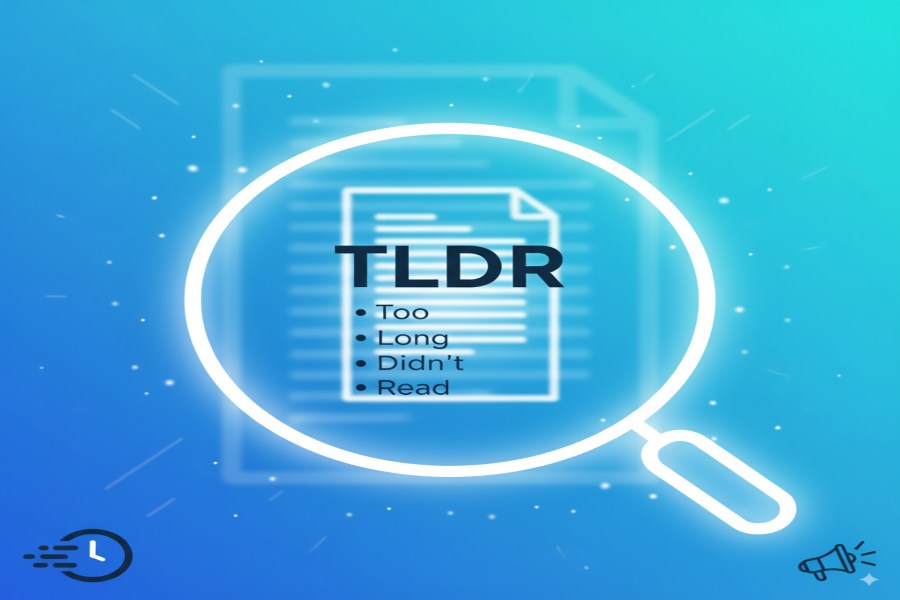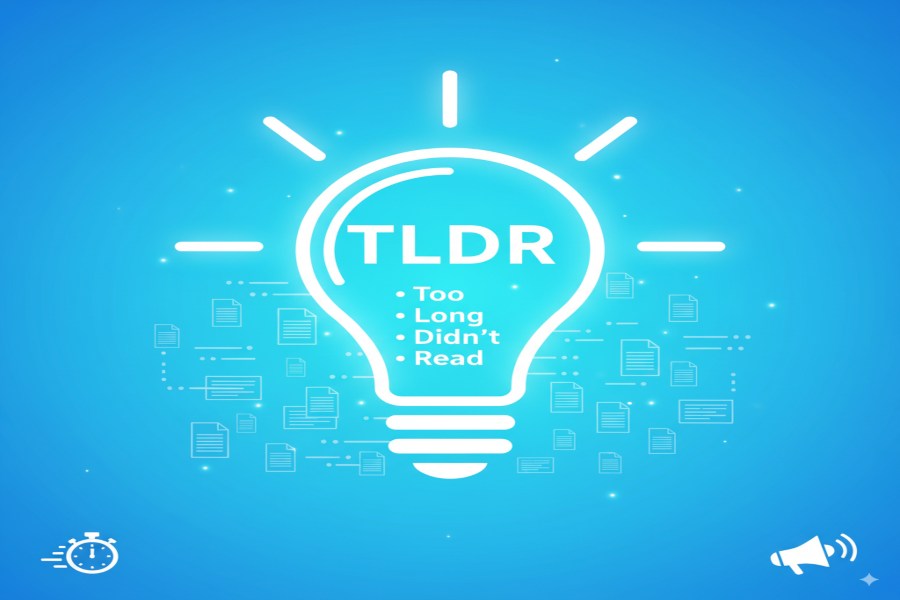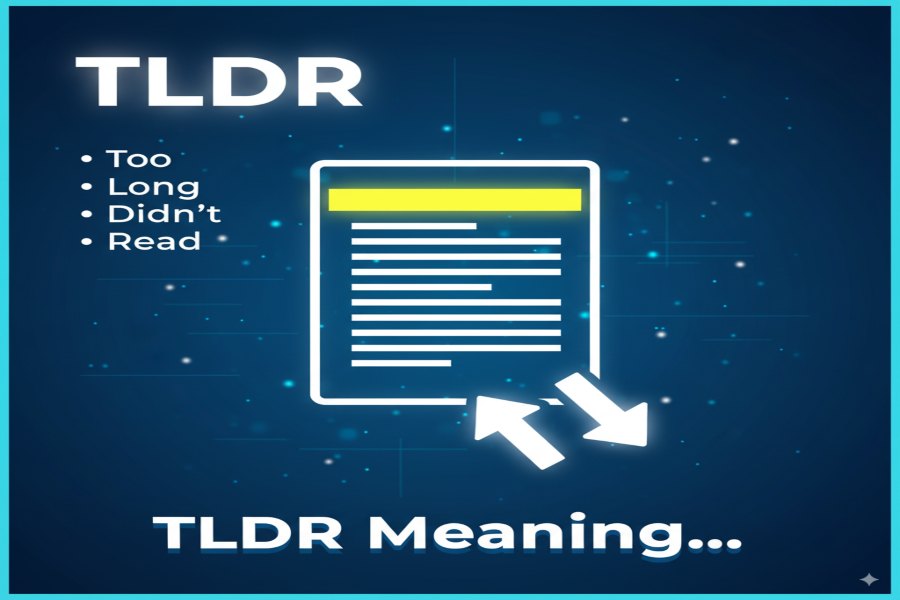In today’s fast-paced digital world, people crave speed and efficiency, especially when it comes to information consumption. One such solution to this need is the acronym TL;DR, which stands for “Too Long; Didn’t Read.”
Whether you’re dealing with long emails, lengthy forum posts, or detailed articles, TL;DR provides a quick, concise summary of the content that helps readers absorb the essential points without sifting through every detail.
In this comprehensive guide, we will explore the meaning, uses, and significance of TL;DR, and how you can effectively use it in both professional and personal communication.
What Does TL;DR Mean?
TL;DR is a shorthand acronym used to indicate that a piece of content, such as an article or message, is too long to read in its entirety. It is often followed by a brief summary of the content or the main points.
The term TL;DR first gained popularity in online forums, particularly on platforms like Reddit, where long posts are common. The acronym served as a way to offer a quick summary to readers who didn’t have time to read lengthy content. Over time, TL;DR became widely accepted in digital communication as a way to make information more accessible and user-friendly.
How to Use TL;DR
Using TL;DR properly can save time and increase efficiency in communication. Here’s how to use it effectively:
- When to Use TL;DR
- For long content: Use TL;DR at the beginning or end of a long post to summarize the key points in a few sentences.
- In professional settings: When sending emails with detailed information or reports, include a TL;DR section to provide a quick overview.
- On social media: Use TL;DR to provide a quick summary of long articles, blogs, or reports that you share on platforms like Twitter, Facebook, or LinkedIn.
- How to Write a TL;DR Summary
- Be concise: Focus on the core idea or main takeaway. Avoid over-explaining.
- Use bullet points: If appropriate, break down the summary into easy-to-digest bullet points.
- Keep it short: TL;DR should not be longer than a few sentences. Its purpose is to condense information.
TL;DR in Different Contexts
The usage of TL;DR can vary depending on the context of the communication. Let’s explore a few examples:

- Professional Communication
- In business emails or reports, TL;DR can be used to highlight the key findings or recommendations without forcing the reader to go through the entire document. For example, “TL;DR: The project is on track, and we’re ready for the next phase.”
- Academic Settings
- In academic writing, TL;DR may be used informally to summarize a complex topic or research paper. However, it’s important to note that TL;DR is not typically appropriate for formal academic writing or journals.
- Social Media
- TL;DR is particularly effective in environments like Twitter, where brevity is key. When sharing a lengthy article or study, a TL;DR version can help your followers grasp the core message without investing too much time.
Common Mistakes People Make with TL;DR
While TL;DR is a useful tool, it’s important to avoid certain common pitfalls:
- Overuse
- Relying too heavily on TL;DR may give the impression that you don’t value the content you’re sharing. It’s crucial to ensure that the summary is useful and not a shortcut for avoiding detailed explanations.
- Misuse
- Using TL;DR in formal settings, such as academic papers or highly professional communications, can be seen as unprofessional. Always assess whether TL;DR fits the context.
- Incomplete Summaries
- A TL;DR summary should capture the essence of the content. Avoid vague or incomplete summaries that fail to convey the main points.
TL;DR vs Other Acronyms: What’s the Difference?
In addition to TL;DR, several other acronyms are often used to summarize content or provide quick insights. Here’s a comparison:
- ICYMI (In Case You Missed It): Often used to reintroduce something important that the reader might have overlooked.
- FWIW (For What It’s Worth): Used when offering an opinion or advice, typically when the speaker is unsure of its value.
- IMO / IMHO (In My Opinion / In My Humble Opinion): Used to preface personal opinions or subjective statements.
Why TL;DR is So Popular
The popularity of TL;DR can be attributed to several factors in our digital age:
- Digital Communication: With the rise of the internet, emails, and social media, people are inundated with large volumes of content daily. TL;DR serves as a way to simplify information consumption.
- Time Constraints: In our fast-paced world, time is valuable. TL;DR allows users to quickly grasp essential points without investing hours of their time.
- Information Overload: With constant streams of information, TL;DR helps us focus on what truly matters.
The Future of TL;DR
As digital communication continues to evolve, TL;DR will likely remain a staple in how we convey information. With the rise of short-form content, such as TikTok videos and Twitter threads, the demand for quick summaries will continue to grow. TL;DR may also evolve as new communication technologies, like AI-powered summarization tools, make information even easier to digest.
TL;DR and Its Role in Digital Communication
TL;DR plays a pivotal role in the digital communication landscape, which has drastically evolved over the last decade. The way we interact with content—whether it’s reading, creating, or sharing—has shifted towards efficiency and brevity. With the rise of social media platforms, blogs, and news outlets, people often find themselves overwhelmed by the sheer volume of information.
Instant Gratification in the Digital Age
In today’s digital age, consumers expect instant gratification. The success of platforms like Twitter, Instagram, and TikTok is rooted in their ability to provide quick snippets of information in an easily digestible format. TL;DR fits seamlessly into this trend, offering an easy solution to the challenge of lengthy content consumption. It allows readers to get the gist of the message within seconds, without needing to invest time in reading a full article or watching a long video.
TL;DR and User Experience (UX)
From a user experience (UX) perspective, TL;DR is an excellent tool for improving content accessibility. The more efficient and intuitive you can make the reading process, the better the user engagement. It’s not just about condensing a lengthy piece of text—it’s about considering the user’s time and cognitive load. If a person is skimming through an article, the TL;DR summary will help them decide if it’s worth reading the full content. This summary is particularly useful in blog posts, online guides, and even e-commerce product descriptions.
For instance, when browsing an online store or reading a technical blog, visitors may not have the patience to wade through long blocks of text. By offering a TL;DR at the top of the page, businesses and bloggers can improve user engagement, increase retention, and drive conversions.
TL;DR in Business and Marketing Communications
In business communication, the need for clear, concise messaging is crucial. Whether you’re sending internal emails, creating reports, or crafting client-facing content, TL;DR can streamline communication and ensure your message is received loud and clear. The key benefit here is reducing miscommunication and increasing efficiency.
TL;DR in Emails and Reports
In professional settings, especially when communicating complex data or reports, TL;DR can be a lifesaver. Executives and managers often have limited time to process information, so including a TL;DR section in your emails or reports can ensure that your audience understands the most critical aspects of your message.
For example, instead of sending a lengthy email detailing a project’s progress, you could open with a TL;DR section: “TL;DR: The project is 80% complete, on schedule, and under budget.” This immediately highlights the key takeaways for the reader, ensuring that they understand the main points without having to read the entire email.
TL;DR and Client Communications
For customer-facing communications, TL;DR ensures that your clients get the essential information quickly, without unnecessary details. In industries such as tech or consulting, where clients often receive detailed proposals or reports, providing a TL;DR summary at the top of your documents or emails can boost customer satisfaction. It shows respect for their time and improves the chances of the message being read.
TL;DR in Education: Enhancing Learning and Engagement
TL;DR has also found a place in educational settings, particularly in online learning environments. As distance learning grows and digital courses become more popular, educators face the challenge of presenting complex information in a format that’s easy for students to digest.
TL;DR in Course Materials
Online course providers can incorporate TL;DR summaries in lecture notes, reading materials, and tutorials. When students are faced with long chapters or academic papers, a TL;DR summary can help them grasp the core concepts quickly before diving into the details. By providing a summary first, educators can increase engagement and help students prioritize the most important material.
For example, if an instructor posts a detailed article on economics, they could include a TL;DR at the beginning, highlighting the key points such as “TL;DR: This article explains the concept of supply and demand, factors influencing market prices, and real-life applications in consumer behavior.”
TL;DR for Academic Writing
Students can also apply TL;DR in their academic work, such as writing research papers or reports. For instance, a TL;DR section in an introduction provides readers with a clear understanding of the topic before delving into the more complex sections of the paper.
This is particularly useful for academic advisors, professors, or peers who are reviewing a student’s work. It gives them an easy-to-understand overview before they examine the supporting arguments or methodology in more detail.
TL;DR in Media and Journalism: A New Era of Storytelling
TL;DR is also revolutionizing the world of media and journalism, especially with the shift towards digital-first publishing. News outlets are increasingly adopting TL;DR-style headlines, teasers, and summaries to cater to readers who may not have time to read long-form articles.

TL;DR in News and Headlines
In the fast-paced world of news, TL;DR helps readers quickly gauge the relevance of an article. Instead of wading through entire pieces of text, readers can skim the TL;DR summary and decide if they want to read the full story. Journalists often use TL;DR to highlight breaking news updates in a concise format, allowing them to capture attention in an age where the average attention span is decreasing.
For example, instead of writing a long headline such as “The U.S. Government Unveils New Environmental Policy That Will Impact All Manufacturing Industries,” a TL;DR-style summary might read: “TL;DR: New U.S. policy targets manufacturers to reduce carbon emissions.” This condensed version gives readers the key idea, allowing them to dive deeper into the details only if they choose to.
TL;DR for Video Content
With the rise of video-based platforms like YouTube and TikTok, TL;DR has even made its way into video descriptions and summaries. Video creators use TL;DR to offer a quick overview of the content, helping viewers decide if they want to watch the entire video. Additionally, creators often provide TL;DR summaries of videos in the comment section or pinned posts to highlight the key moments.
TL;DR in Social Media: Enhancing User Interaction
Social media platforms thrive on brevity. With the character limits on Twitter and the quick-scroll culture on Instagram, TL;DR has become an essential tool for condensing content and improving engagement.
TL;DR for Posts and Threads
On Twitter, where space is limited, TL;DR is often used to summarize lengthy threads. Users will write a thread with several tweets elaborating on a topic, but at the beginning or end, they’ll post a TL;DR to condense the information into a few key points. This helps followers quickly digest the main points without needing to read the entire thread.
TL;DR in Instagram Captions
On platforms like Instagram, TL;DR can be used in the caption to summarize the main point of a post. Influencers and brands often provide TL;DR-style captions to ensure their audience can get the gist of their message without reading lengthy text.
Conclusion
TL;DR is a simple yet powerful acronym that saves time and enhances communication. By offering concise summaries of lengthy content, it helps readers and writers focus on what matters most. Understanding how and when to use TL;DR is crucial for improving digital communication, whether in professional emails, social media posts, or even academic discussions.

